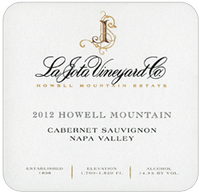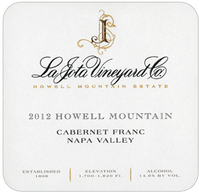La Jota Vineyard Co., Napa Valley – Howell Mountain Cabernet Sauvignon 2012 and Cabernet Franc 2012 (each $75): I have always admired California’s mountain wines. Their vines usually are dry-farmed and grow in poor, infertile soil, producing small crops of intensely flavored grapes. Altitude and slope bring superior illumination to the vines to aid ripening in climates that are cooler on average than those of valley-floor vineyards. Mountain-grown red wines can be huge but they are often compact as well, with an intriguing precision of flavor.
In Napa Valley’s diverse topography, four of the sixteen AVAs are mountain districts. In the Mayacamas Mountains of western Napa County are Spring Mountain, Diamond Mountain and Mt. Veeder, and in the Vaca Range east of the famous valley-floor and benchland districts is the Howell Mountain AVA. In 1983, Howell Mountain became the first  AVA within the larger Napa Valley AVA. Nearly a century earlier, pioneering vintners such as Charles Krug brought viticulture to Howell Mountain, and by the end of that century wines from Howell Mountain had won medals in world wine competitions in Paris.
AVA within the larger Napa Valley AVA. Nearly a century earlier, pioneering vintners such as Charles Krug brought viticulture to Howell Mountain, and by the end of that century wines from Howell Mountain had won medals in world wine competitions in Paris.
All vineyards in the Howell Mountain AVA lie at altitudes above 1400 feet. The critical feature of this altitude is that the vineyards are above the fog line and remain sunny when the fog rolls onto the lower vineyards nearer the coast. Temperatures tend to remain steady, with warmer nights than many of the lower districts but without their heat spikes during the day.
La Jota Vineyard Co. dates back to 1898 when Swiss immigrant Frederick Hess built a stone winery on part of Rancho La Jota, a Mexican land grant atop Howell Mountain. La Jota wines were among those that won international acclaim more than 100 years ago. Today that original winery is the site of La Jota’s winemaking operations.
La Jota 2012 Cabernet Franc and 2012 Cabernet Sauvignon were both standouts in a small blind tasting I recently conducted. The La Jota Cabernet Franc ($75) is the most powerful Cabernet Franc wine I have ever tasted, and it overshadowed the Cabernet Sauvignon in intensity and weight. And no wonder: The wine comes from vines nearly 40 years old (planted on St. George rootstock, they are not vulnerable to phylloxera) on a site that regularly yields only about 1.5 tons of grapes per acre. Winemaker Chris Carpenter enabled the site’s natural intensity, rather than trying to subdue it, by aging the wine for 20 months in 81 percent  new French oak. When first tasted, the wine seems tannic to the point of imbalace, but with air the rich, spicy fruit begins to speak. Aromas and flavors of blueberry, cherry and bramble fruit mix with savory mineral and spice character and submerge the strong tannin. Italians would call this a “vino di meditazione.”
new French oak. When first tasted, the wine seems tannic to the point of imbalace, but with air the rich, spicy fruit begins to speak. Aromas and flavors of blueberry, cherry and bramble fruit mix with savory mineral and spice character and submerge the strong tannin. Italians would call this a “vino di meditazione.”
The 2012 La Jota Cabernet Sauvignon in comparison seems quite an elegant wine. Actually, it is also full-bodied and powerful but is components work together so gracefully that the wine’s power is almost an afterthought. When you smell this wine, you are likely to notice a fine herbal scent of anise alongside dark berry notes, dried berries and bittersweet chocolate; in your mouth, red fruit notes and earthy minerality emerge. At this young age, the wine still shows its oak tannin, but the freshness and vibrancy of the fruit harmonize beautifully with the tannin so that the tannin assumes mainly a textural function. If you think about the fruit, you can taste how focused and precise the flavors are — typical of mountain fruit. According to Carpenter, this Cabernet Sauvignon can age for decades in the bottle.
For my taste, the Cabernet Sauvignon is the choice, but the Cabernet Franc is an equally fine wine. The Cabernet Sauvignon has the larger production, at 3928 cases compared to only 355 cases for the Cabernet Franc.
Cabernet Franc, 91 Points
Cabernet Sauvignon, 92 Points
